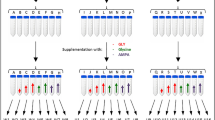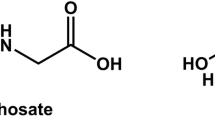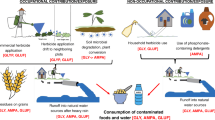Abstract
The preoccupation concerning glyphosate (GLYP) has rapidly grown over recent years, and the availability of genetically modified crops that are resistant to GLYP or glufosinate (GLUF) has increased the use of these herbicides. The debate surrounding the carcinogenicity of GLYP has raised interest and the desire to gain information on the level of exposure of the population. GLYP and aminomethylphosphonic acid (AMPA) are commonly simultaneously analysed. GLUF is sometimes also monitored, but its major metabolite, 3-[hydroxy(methyl)phosphinoyl]propionic acid (3MPPA), is rarely present in the method. Using a pentafluorobenzyl derivative to extract the analytes from human urine, we present a method that contains four important analytes to monitor human exposure to GLYP and GLUF. The use of the flash freeze technique speeds up the extraction process and requires less organic solvent than conventional liquid-liquid extraction. The limits of detection in the low μg/L range enable the use of this method for epidemiological studies. The results obtained for 35 volunteers from the Quebec City area are presented with the results from multiple interlaboratory comparisons (G-EQUAS, HBM4EU and OSEQAS). This methodology is currently being used in the Maternal-Infant Research on Environmental Chemicals (MIREC-ENDO) study and in the Canadian Health Measures Survey (CHMS).
Graphical abstract



Similar content being viewed by others
References
Duke SO. Taking stock of herbicide-resistant crops ten years after introduction. Pest Manag Sci. 2005;61:211–8.
Müller BP, Zumdick A, Schuphan I, Schmidt B. Metabolism of the herbicide glufosinate-ammonium in plant cell cultures of transgenic (rhizomania-resistant) and non-transgenic sugarbeet (Beta vulgaris), carrot (Daucus carota), purple foxglove (Digitalis purpurea) and thorn apple (Datura stramonium). Pest Manag Sci. 2001;57:46–56.
Ministère de l’Environnement et de la Lutte contre les changements climatiques. Bilan des ventes de pesticides au Québec – 2018. [En ligne], Québec. 2020; 81 p. http://www.environnement.gouv.qc.ca/pesticides/bilan/. Accessed 6 Jul 2020.
Portier CJ, Armstrong BK, Baguley BC, Baur X, Belyaev I, Bellé R, et al. Differences in the carcinogenic evaluation of glyphosate between the International Agency for Research on Cancer (IARC) and the European Food Safety Authority (EFSA). J Epidemiol Community Health. 2016;70:741–5.
Tarazona JV, Court-Marques D, Tiramani M, Reich H, Pfeil R, Istace F, et al. Glyphosate toxicity and carcinogenicity: a review of the scientific basis of the European Union assessment and its differences with IARC. Arch Toxicol. 2017;91:2723–43.
Duke SO. Glyphosate degradation in glyphosate-resistant and-susceptible crops and weeds. J Agric Food Chem. 2011;59:5835–41.
Jensen PK, Wujcik CE, McGuire MK, McGuire MA. Validation of reliable and selective methods for direct determination of glyphosate and aminomethylphosphonic acid in milk and urine using LC-MS/MS. J Environ Sci Health B. 2016;51:254–9.
Benbrook CM. How did the US EPA and IARC reach diametrically opposed conclusions on the genotoxicity of glyphosate-based herbicides? Environ Sci Eur. 2019;31:2.
Yoshioka N, Asano M, Kuse A, Mitsuhashi T, Nagasaki Y, Ueno Y. Rapid determination of glyphosate, glufosinate, bialaphos, and their major metabolites in serum by liquid chromatography-tandem mass spectrometry using hydrophilic interaction chromatography. J Chromatogr A. 2011;1218:3675–80.
Connolly A, Jones K, Basinas I, Galea KS, Kenny L, McGowan P, et al. Exploring the half-life of glyphosate in human urine samples. Int J Hyg Environ Health. 2019;222:205–10.
Hirose Y, Kobayashi M, Koyama K, Kohda Y, Tanaka T, Honda H, et al. A toxicokinetic analysis in a patient with acute glufosinate poisoning. Hum Exp Toxicol. 1999;18:305–8.
Hori Y, Fujisawa M, Shimada K, Hirose Y. Determination of the herbicide glyphosate and its metabolite in biological specimens by gas chromatography-mass spectrometry. A case of poisoning by roundup herbicide. J Anal Toxicol. 2003;27:162–6.
Hori Y, Fujisawa M, Shimada K, Hirose Y. Determination of glufosinate ammonium and its metabolite, 3-methylphosphinicopropionic acid, in human serum by gas chromatography-mass spectrometry following mixed-mode solid-phase extraction and t-BDMS derivatization. J Anal Toxicol. 2001;25:680–4.
Aris A, Leblanc S. Maternal and fetal exposure to pesticides associated to genetically modified foods in Eastern Townships of Quebec, Canada. Reprod Toxicol. 2011;31:528–33.
Guo H, Wang H, Zheng J, Liu W, Zhong J, Zhao Q. Sensitive and rapid determination of glyphosate, glufosinate, bialaphos and metabolites by UPLC-MS/MS using a modified quick polar pesticides extraction method. Forensic Sci Int. 2018;283:111–7.
Zoller O, Rhyn P, Zarn JA, Dudler V. Urine glyphosate level as a quantitative biomarker of oral exposure. Int J Hyg Environ Health. 2020;228:113526.
Connolly A, Coggins MA, Koch HM. Human biomonitoring of glyphosate exposures: state-of-the-art and future research challenges. Toxics. 2020;8:E60.
Jaworska J, Van Genderen-Takken H, Hanstveit A, van de Plassche E, Feijtel T. Environmental risk assessment of phosphonates, used in domestic laundry and cleaning agents in the Netherlands. Chemosphere. 2002;47:655–65.
Kazui Y, Seto Y, Inoue H. Phosphorus-specific determination of glyphosate, glufosinate, and their hydrolysis products in biological samples by liquid chromatography–inductively coupled plasma–mass spectrometry. Forensic Toxicol. 2014;32:317–22.
Sato M, Yamashita A, Kikuchi M, Ito T, Honda M. Simultaneous analysis of phosphorus-containing amino acid type herbicides and their metabolites in human samples using N-acetyl,O-methyl derivatives by LC/MS. Jpn J Forensic Sci Technol. 2009;14:35–43.
Tsikas D. Pentafluorobenzyl bromide-A versatile derivatization agent in chromatography and mass spectrometry: I. Analysis of inorganic anions and organophosphates. J Chromatogr B Anal Technol Biomed Life Sci. 2017;1043:187–201.
Kojro G, Rudzki PJ, Pisklak DM, Giebułtowicz J. Matrix effect screening for cloud-point extraction combined with liquid chromatography coupled to mass spectrometry: bioanalysis of pharmaceuticals. J Chromatogr A. 2019;1591:44–54.
Patel BN, Sharma N, Sanyal M, Shrivastav PS. Simultaneous determination of simvastatin and simvastatin acid in human plasma by LC-MS/MS without polarity switch: application to a bioequivalence study. J Sep Sci. 2008;31:301–13.
Yanagisawa K, Harada M, Okada T. Liquid–liquid extraction from frozen aqueous phases enhances efficiency with reduced volumes of organic solvent. ACS Sustain Chem Eng. 2018;6:10120–6.
Motojyuku M, Saito T, Akieda K, Otsuka H, Yamamoto I, Inokuchi S. Determination of glyphosate, glyphosate metabolites, and glufosinate in human serum by gas chromatography-mass spectrometry. J Chromatogr B Anal Technol Biomed Life Sci. 2008;875:509–14.
Gaudreau É, Bérubé R, Bienvenu JF, Fleury N. Stability issues in the determination of 19 urinary (free and conjugated) monohydroxy polycyclic aromatic hydrocarbons. Anal Bioanal Chem. 2016;408:4021–33.
Bienvenu J-F, Provencher G, Bélanger P, Bérubé R, Dumas P, Gagné S, et al. Standardized procedure for the simultaneous determination of the matrix effect, recovery, process efficiency, and internal standard association. Anal Chem. 2017;89:7560–8.
Valle AL, Mello FCC, Alves-Balvedi RP, Rodrigues LP, Goulart LR. Glyphosate detection: methods, needs and challenges. Environ Chem Lett. 2019;17(1):291–317.
Huhn C. More and enhanced glyphosate analysis is needed. Anal Bioanal Chem. 2018;410(13):3041–5.
Vander Heyden Y, Nijhuis A, Smeyers-Verbeke J, Vandeginste BGM, Massart DL. Guidance for robustness/ruggedness tests in method validation. J Pharm Biomed Anal. 2001;24:723–53.
Connolly A, Basinas I, Jones K, Galea KS, Kenny L, McGowan P, et al. Characterising glyphosate exposures among amenity horticulturists using multiple spot urine samples. Int J Hyg Environ Health. 2018;221:1012–22.
Connolly A, Koslitz S, Bury D, Brüning T, Conrad A, Kolossa-Gehring M, et al. Sensitive and selective quantification of glyphosate and aminomethylphosphonic acid (AMPA) in urine of the general population by gas chromatography-tandem mass spectrometry. J Chromatogr B Anal Technol Biomed Life Sci. 2020;1158:122348.
Acknowledgements
The authors wish to acknowledge the contributions of Anny-France Hudon, Claudine Roussy, Nathalie Morissette and Marie-Pier Ouellet, who collaborated with us to develop and improve this analytical method.
Funding
Financial support was provided by an internal budget dedicated to development and research.
Author information
Authors and Affiliations
Corresponding author
Ethics declarations
Ethics approval
This study involves the use of human urine samples collected from multiple volunteer donors, including laboratory staff and members of their family. According to the rules and regulations concerning ethical review in Québec, particularly those specified in the Civil Code (http://legisquebec.gouv.qc.ca/fr/ShowDoc/cs/CCQ-1991) and in subsequent IRB practice, appropriate regulation was followed for the current project because it was considered as evaluation and therefore, no IRB was required.
Consent to participate
We obtained the consent of all participants (or parental consent in case of minors) to use the urine samples for method development and validation, and they may also be used for research and publications. Participants were protected by the removal of any personal identifiers that may have linked the participant to the donation. The samples were coded to maintain the anonymity of the participants and disconnect the identity of each participant from the data generated from their urine sample. Furthermore, all the staff members of the CTQ are required to sign a confidentiality agreement upon hiring.
Conflict of interest
The authors declare no conflict of interest.
Additional information
Publisher’s note
Springer Nature remains neutral with regard to jurisdictional claims in published maps and institutional affiliations.
Supplementary information
ESM 1
(PDF 1.03 mb).
Rights and permissions
About this article
Cite this article
Bienvenu, JF., Bélanger, P., Gaudreau, É. et al. Determination of glyphosate, glufosinate and their major metabolites in urine by the UPLC-MS/MS method applicable to biomonitoring and epidemiological studies. Anal Bioanal Chem 413, 2225–2234 (2021). https://doi.org/10.1007/s00216-021-03194-x
Received:
Revised:
Accepted:
Published:
Issue Date:
DOI: https://doi.org/10.1007/s00216-021-03194-x




